ECU VOLVO S60 TWIN ENGINE 2019 Owner's Manual
[x] Cancel search | Manufacturer: VOLVO, Model Year: 2019, Model line: S60 TWIN ENGINE, Model: VOLVO S60 TWIN ENGINE 2019Pages: 645, PDF Size: 13.96 MB
Page 233 of 645

KEY, LOCKS AND ALARM
* Option/accessory.231
NOTE
Be aware of the risk of locking the remotekey in the vehicle.
If the remote key or key tag is left in thevehicle, it will be deactivated when thevehicle is locked and the alarm set usinganother valid key. The key will be reacti-vated when the vehicle is unlocked.
If the remote key or Red Key is left in thevehicle, it will be deactivated even if thevehicle is locked using Volvo On Call, andwill be reactivated when the vehicle isunlocked using Volvo On Call or anothervalid key.
Button-less key (Key Tag) *
The button-less key4 provided with the keylesslocking and unlocking function works in the sameway as the regular remote key for keyless start,locking and unlocking. The key is waterproof upto a depth of approx. 10 meters (30 feet) for upto 60 minutes. It does not have a detachable keyblade and its battery cannot be replaced.
Red Key - restricted remote key *
A Red Key is a key that makes it possible to setrestrictions for some of the vehicle's functions,e.g. maximum speed and maximum audio systemvolume. It helps vehicle owners ensure that the
vehicle is being operated responsibly by other dri-vers.
Interference
Electromagnetic fields or obstructing objects mayinterfere with the remote key's functions for key-less start and keyless locking and unlocking*.
NOTE
Avoid storing the remote control key nearmetal objects or electronic devices, e.g. cellphones, tablets, laptops or chargers – pref-erably no closer than 10-15 cm (4-6 in.).
If you experience interference, use the remotekey's detachable blade to unlock the vehicle andplace the remote key in the backup key reader inthe tunnel console cup holder to disarm thealarm.
NOTE
When the remote control key is placed in thecup holder, make sure that no other vehiclekeys, metal objects or electronic devices (e.g.cell phones, tablets, laptops or chargers) arefound in the cup holder. Multiple vehicle keysclose to each other in the cup holder can dis-rupt their functionality.
WARNING
California Proposition 65
Operating, servicing and maintaining a pas-senger vehicle can expose you to chemicalsincluding engine exhaust, carbon monoxide,phthalates, and lead, which are known to theState of California to cause cancer and birthdefects or other reproductive harm. To mini-mize exposure, avoid breathing exhaust, donot idle the engine except as necessary, serv-ice your vehicle in a well ventilated area andwear gloves or wash your hands frequentlywhen servicing your vehicle. For more infor-mation go to www.P65Warnings.ca.gov/passenger-vehicle.
Related information
Locking and unlocking using the remote key(p. 232)
Remote key range (p. 234)
Replacing the remote key's battery (p. 234)
Detachable key blade (p. 240)
Electronic immobilizer (p. 243)
Linking a remote key to a driver profile(p. 136)
4Also called sport key.
Page 240 of 645
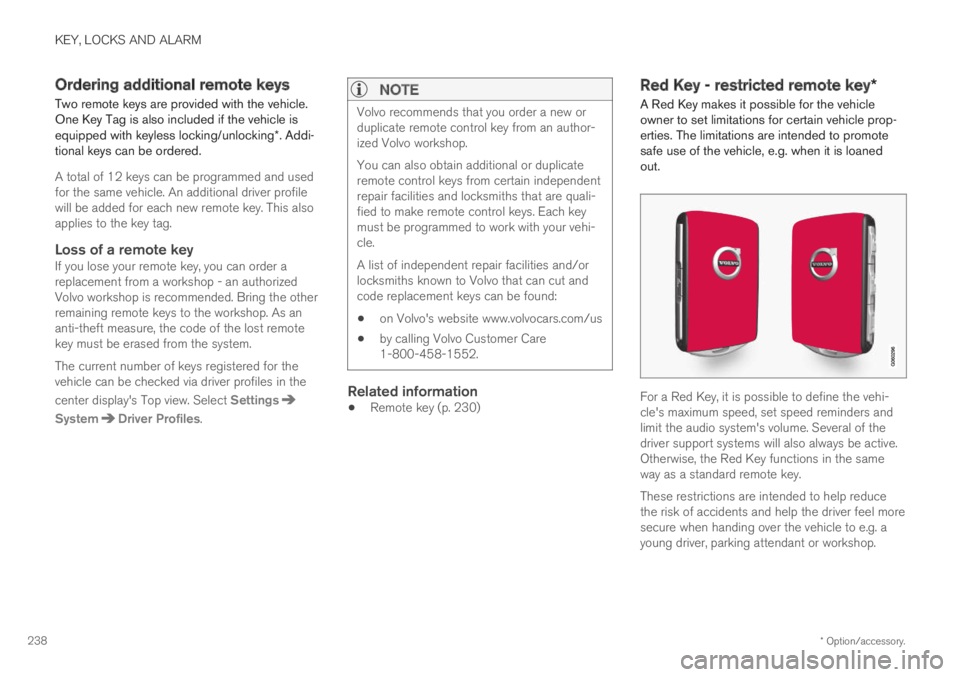
KEY, LOCKS AND ALARM
* Option/accessory.238
Ordering additional remote keys
Two remote keys are provided with the vehicle.One Key Tag is also included if the vehicle isequipped with keyless locking/unlocking*. Addi-tional keys can be ordered.
A total of 12 keys can be programmed and usedfor the same vehicle. An additional driver profilewill be added for each new remote key. This alsoapplies to the key tag.
Loss of a remote key
If you lose your remote key, you can order areplacement from a workshop - an authorizedVolvo workshop is recommended. Bring the otherremaining remote keys to the workshop. As ananti-theft measure, the code of the lost remotekey must be erased from the system.
The current number of keys registered for thevehicle can be checked via driver profiles in the
center display's Top view. Select Settings
SystemDriver Profiles.
NOTE
Volvo recommends that you order a new orduplicate remote control key from an author-ized Volvo workshop.
You can also obtain additional or duplicateremote control keys from certain independentrepair facilities and locksmiths that are quali-fied to make remote control keys. Each keymust be programmed to work with your vehi-cle.
A list of independent repair facilities and/orlocksmiths known to Volvo that can cut andcode replacement keys can be found:
on Volvo's website www.volvocars.com/us
by calling Volvo Customer Care1-800-458-1552.
Related information
Remote key (p. 230)
Red Key - restricted remote key*
A Red Key makes it possible for the vehicleowner to set limitations for certain vehicle prop-erties. The limitations are intended to promotesafe use of the vehicle, e.g. when it is loanedout.
For a Red Key, it is possible to define the vehi-cle's maximum speed, set speed reminders andlimit the audio system's volume. Several of thedriver support systems will also always be active.Otherwise, the Red Key functions in the sameway as a standard remote key.
These restrictions are intended to help reducethe risk of accidents and help the driver feel moresecure when handing over the vehicle to e.g. ayoung driver, parking attendant or workshop.
Page 243 of 645

KEY, LOCKS AND ALARM
}}
241
Put the key blade back into its designatedspot in the remote key after use.
Replace the cover by pressing it downuntil it clicks into place.
Slide the cover back.
>An additional click indicates that the coveris correctly in place.
Related information
Locking and unlocking with detachable keyblade (p. 241)
Remote key (p. 230)
Locking and unlocking withdetachable key blade
The detachable key blade can be used to unlockthe vehicle from the outside, e.g. if the battery inthe remote key is discharged.
Unlocking
Pull the front left-hand door handle to its endposition to access the lock cylinder.
Put the key in the lock cylinder.
Turn the key clockwise 45 degrees so thatthe key blade is pointing straight rearward.
Turn the key blade back 45 degrees to itsoriginal position. Remove the key from thelock cylinder and release the handle so that itreturns to its original position against thevehicle.
5.Pull the door handle.
> The door will open.
Lock the door in the same way, but turn the key45 degrees counterclockwise in step (3).
Turning off the alarm
NOTE
When the door is unlocked using the detach-able key blade and then opened, the alarmwill be triggered.
Location of the backup key reader in the cup holder.
Turn off the alarm by:
1.Place the remote control key on the key sym-bol in the backup reader in the bottom of thecup holder in the tunnel console.
2. Turn the start knob clockwise and release it.
> The alarm signal will stop and the alarmwill switch off.
Page 245 of 645

KEY, LOCKS AND ALARM
}}
* Option/accessory.243
Electronic immobilizer
The electronic immobilizer is a start inhibitor thathelps prevent the vehicle from being started byan unauthorized person.
The vehicle can only be started with the rightremote key.
The following instrument panel error messagesare related to the electronic immobilizer:
SymbolMessageMeaning
Vehicle keynot found
SeeOwner'smanual
Remote key notrecognized duringstart. Place theremote key on thekey symbol in thecup holder and tryto start the vehicleagain.
Remote immobilizer with tracking
system 9
The vehicle is equipped with a system that makesit possible to track and locate the vehicle and toremotely activate the immobilizer to prevent thevehicle from being started. Contact your nearestVolvo retailer for more information and assistanceactivating the system.
The following instrument panel error messagesare related to the remote immobilizer with track-ing system:
SymbolMessageMeaning
Remotelyimmobilised
Vehicle notpossible tostart
The remoteimmobilizer withtracking system isactivated. Thevehicle cannot bestarted. ContactVolvo On CallService Center.
Related information
Remote key (p. 230)
Ordering additional remote keys (p. 238)
Start and lock system typedesignations
The following information contains type designa-tions for the start and lock system.
Alarm system
USA FCC ID: MAYDA 5823(3)
This device complies with part 15 of the FCCrules. Operation is subject to the following condi-tions: (1) This device may not cause harmfulinterference, and (2) this device must accept anyinterference received, including interference thatmay cause undesired operation.
Canada IC: 4405A-DA 5823(3)
This device is subject to the following conditions:(1) this device may not cause interference, and(2) this device must accept any interference,including interference that may cause undesiredoperation of the device.
Remote keys (Passive Entry * /Passive
Start)
USA
Volvo Standard Key FCC ID: YGOHUF8423
Volvo Tag ID FCC ID: YGOHUF8432
This device complies with part 15 of the FCCrules. Operation is subject to the following twoconditions:
9
Only certain markets and in combination with Volvo On Call.
Page 253 of 645
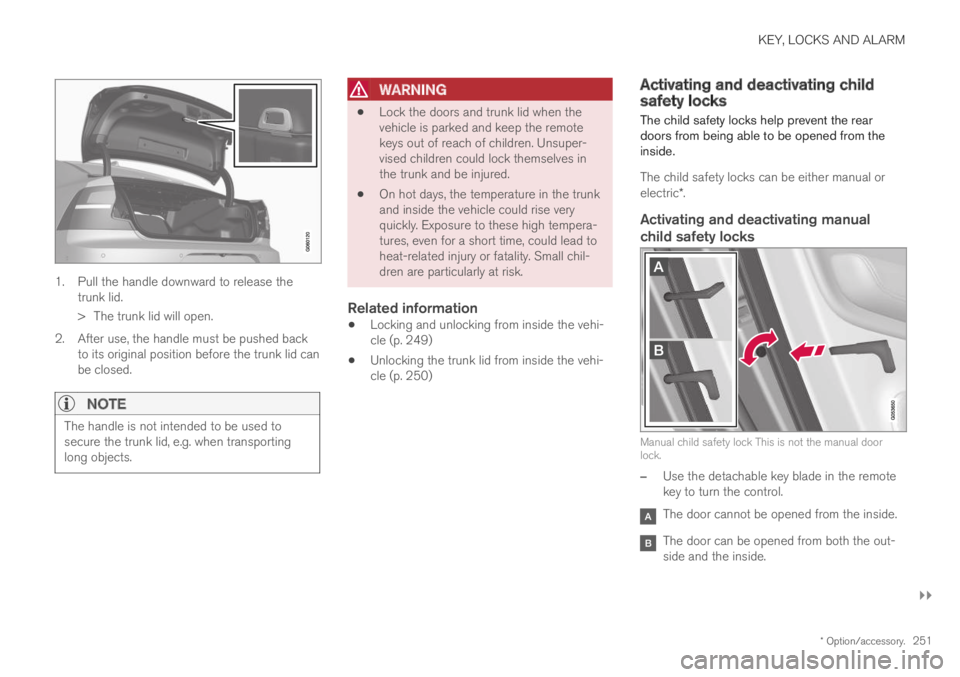
KEY, LOCKS AND ALARM
}}
* Option/accessory.251
1. Pull the handle downward to release thetrunk lid.
>The trunk lid will open.
2. After use, the handle must be pushed backto its original position before the trunk lid canbe closed.
NOTE
The handle is not intended to be used tosecure the trunk lid, e.g. when transportinglong objects.
WARNING
Lock the doors and trunk lid when thevehicle is parked and keep the remotekeys out of reach of children. Unsuper-vised children could lock themselves inthe trunk and be injured.
On hot days, the temperature in the trunkand inside the vehicle could rise veryquickly. Exposure to these high tempera-tures, even for a short time, could lead toheat-related injury or fatality. Small chil-dren are particularly at risk.
Related information
Locking and unlocking from inside the vehi-cle (p. 249)
Unlocking the trunk lid from inside the vehi-cle (p. 250)
Activating and deactivating childsafety locks
The child safety locks help prevent the reardoors from being able to be opened from theinside.
The child safety locks can be either manual orelectric*.
Activating and deactivating manual
child safety locks
Manual child safety lock This is not the manual doorlock.
–Use the detachable key blade in the remotekey to turn the control.
The door cannot be opened from the inside.
The door can be opened from both the out-side and the inside.
Page 255 of 645
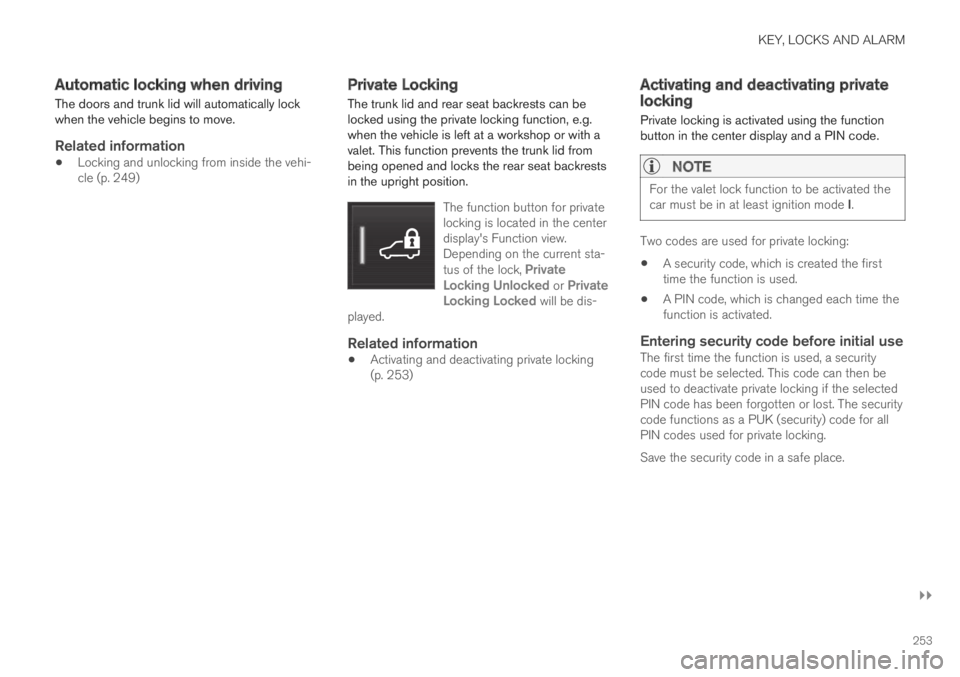
KEY, LOCKS AND ALARM
}}
253
Automatic locking when driving
The doors and trunk lid will automatically lockwhen the vehicle begins to move.
Related information
Locking and unlocking from inside the vehi-cle (p. 249)
Private Locking
The trunk lid and rear seat backrests can belocked using the private locking function, e.g.when the vehicle is left at a workshop or with avalet. This function prevents the trunk lid frombeing opened and locks the rear seat backrestsin the upright position.
The function button for privatelocking is located in the centerdisplay's Function view.Depending on the current sta-tus of the lock, PrivateLocking Unlocked or PrivateLocking Locked will be dis-played.
Related information
Activating and deactivating private locking(p. 253)
Activating and deactivating privatelocking
Private locking is activated using the functionbutton in the center display and a PIN code.
NOTE
For the valet lock function to be activated thecar must be in at least ignition mode I.
Two codes are used for private locking:
A security code, which is created the firsttime the function is used.
A PIN code, which is changed each time thefunction is activated.
Entering security code before initial use
The first time the function is used, a securitycode must be selected. This code can then beused to deactivate private locking if the selectedPIN code has been forgotten or lost. The securitycode functions as a PUK (security) code for allPIN codes used for private locking.
Save the security code in a safe place.
Page 256 of 645
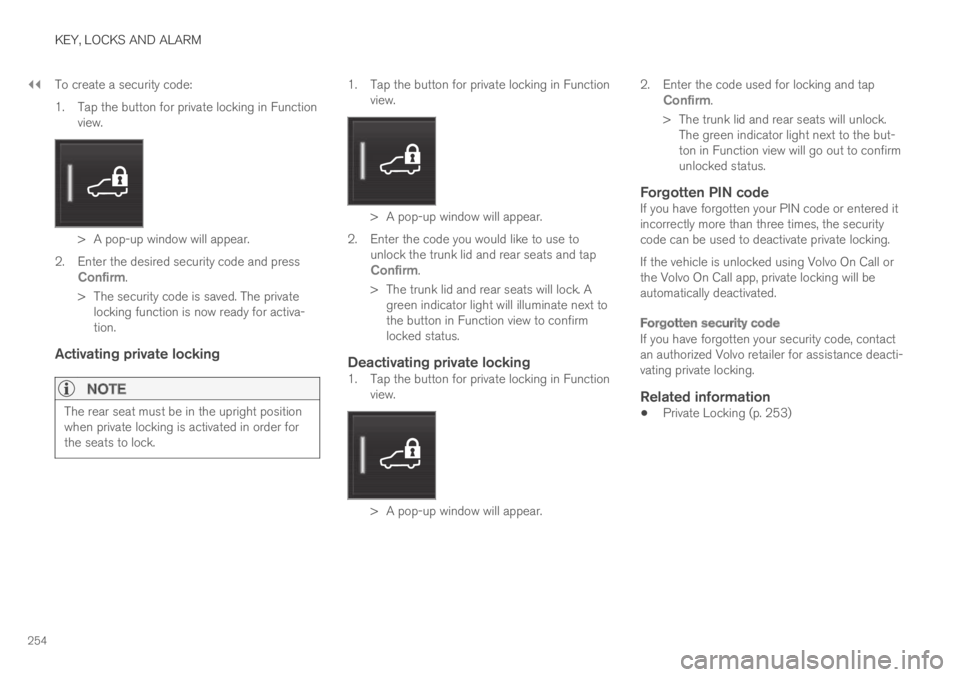
||
KEY, LOCKS AND ALARM
254
To create a security code:
1. Tap the button for private locking in Functionview.
> A pop-up window will appear.
2.Enter the desired security code and pressConfirm.
>The security code is saved. The privatelocking function is now ready for activa-tion.
Activating private locking
NOTE
The rear seat must be in the upright positionwhen private locking is activated in order forthe seats to lock.
1. Tap the button for private locking in Functionview.
> A pop-up window will appear.
2.Enter the code you would like to use tounlock the trunk lid and rear seats and tapConfirm.
>The trunk lid and rear seats will lock. Agreen indicator light will illuminate next tothe button in Function view to confirmlocked status.
Deactivating private locking
1. Tap the button for private locking in Functionview.
> A pop-up window will appear.
2.Enter the code used for locking and tapConfirm.
>The trunk lid and rear seats will unlock.The green indicator light next to the but-ton in Function view will go out to confirmunlocked status.
Forgotten PIN code
If you have forgotten your PIN code or entered itincorrectly more than three times, the securitycode can be used to deactivate private locking.
If the vehicle is unlocked using Volvo On Call orthe Volvo On Call app, private locking will beautomatically deactivated.
Forgotten security code
If you have forgotten your security code, contactan authorized Volvo retailer for assistance deacti-vating private locking.
Related information
Private Locking (p. 253)
Page 277 of 645

DRIVER SUPPORT
}}
* Option/accessory.275
Starting/activating Adaptive Cruise
Control
To start ACC:
The driver's seat belt must be buckled andthe driver's door must be closed.
There must be a vehicle ahead (target vehi-cle) within a reasonable distance or yourvehicle's current speed must be at least15 km/h (9 mph).
–With the (4) function displayed, press
(1) on the steering wheel keypad.
>Adaptive Cruise Control will start and thecurrent speed will be stored, which will beshown by numbers in the center of thespeedometer.
ACC will only regulate the timeinterval to the vehicle aheadwhen the distance symbolshows two vehicles.
A speed interval will be markedat the same time.
The higher speed is the setspeed for your vehicle and thelower speed is the speed of thevehicle ahead (target vehicle).
Related information
Adaptive Cruise Control* (p. 272)
Deactivating/reactivating Adaptive CruiseControl* (p. 275)
Switching between Cruise Control and Adap-tive Cruise Control* (p. 277)
Deactivating/reactivating Adaptive
Cruise Control*
Adaptive Cruise Control (ACC24) can be tempo-rarily put into standby mode and then reactiva-ted.
Deactivating and putting Adaptive
Cruise Control in standby mode
24Adaptive Cruise Control
Page 294 of 645

DRIVER SUPPORT
* Option/accessory.292
Set time interval for driver support
The time interval to the vehicle ahead can be set
for the functions Adaptive Cruise Control*37,Pilot Assist and Distance Alert*.
Different time intervals to thevehicle ahead can be selectedand are shown in the instru-ment panel as 1–5 horizontalbars. The more bars, the longerthe time interval. One bar rep-resents an interval ofapprox. 1 second to the vehicle ahead. 5 barsrepresents approx. 3 seconds.
NOTE
When the symbol in the instrument panelshows a vehicle and a steering wheel, PilotAssist follows a vehicle ahead at a presettime interval.
When only a steering wheel is shown, there isno vehicle ahead within a reasonable dis-tance.
NOTE
When the symbol in the instrument panelshows two vehicles, ACC is following the vehi-cle ahead at a preset time interval.
When only one vehicle is shown, there is novehicle ahead within a reasonable distance.
Controls for setting a time interval.
Reduce the time interval
Increase the time interval
Distance indicator
–Press the (1) or (2) button to decrease orincrease the time interval.
>The distance indicator (3) shows the cur-rent time interval.
In order to help your vehicle follow the vehicleahead as smoothly and comfortably as possible,Adaptive Cruise Control allows the time intervalto vary noticeably in certain situations. At lowspeeds, when the distance to the vehicle aheadis short, Adaptive Cruise Control increases thetime interval slightly.
NOTE
The greater the vehicles' speed, thegreater the distance between them for aset time interval.
Only use the time intervals permitted bylocal traffic regulations.
If driver support does not seem torespond with a speed increase when acti-vated, it may be because the time intervalto the vehicle ahead is shorter than theset time interval.
WARNING
Only use a time interval suitable for thecurrent traffic conditions.
The driver should be aware that shorttime intervals give them limited time toreact and act to any unforeseen trafficsituation.
37Adaptive Cruise Control
Page 340 of 645
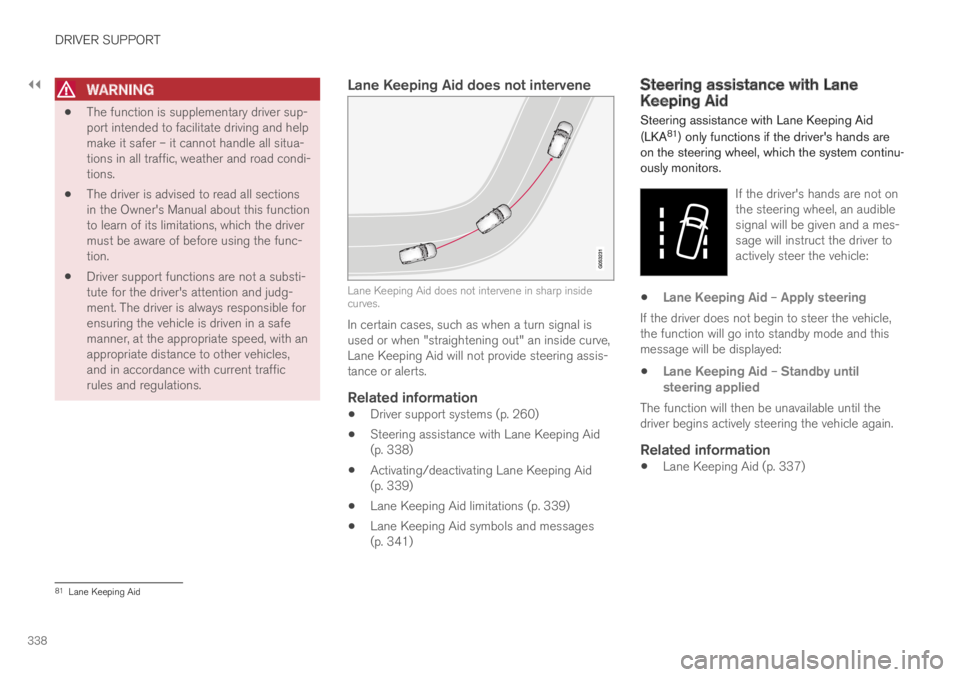
||
DRIVER SUPPORT
338
WARNING
The function is supplementary driver sup-port intended to facilitate driving and helpmake it safer – it cannot handle all situa-tions in all traffic, weather and road condi-tions.
The driver is advised to read all sectionsin the Owner's Manual about this functionto learn of its limitations, which the drivermust be aware of before using the func-tion.
Driver support functions are not a substi-tute for the driver's attention and judg-ment. The driver is always responsible forensuring the vehicle is driven in a safemanner, at the appropriate speed, with anappropriate distance to other vehicles,and in accordance with current trafficrules and regulations.
Lane Keeping Aid does not intervene
Lane Keeping Aid does not intervene in sharp insidecurves.
In certain cases, such as when a turn signal isused or when "straightening out" an inside curve,Lane Keeping Aid will not provide steering assis-tance or alerts.
Related information
Driver support systems (p. 260)
Steering assistance with Lane Keeping Aid(p. 338)
Activating/deactivating Lane Keeping Aid(p. 339)
Lane Keeping Aid limitations (p. 339)
Lane Keeping Aid symbols and messages(p. 341)
Steering assistance with LaneKeeping Aid
Steering assistance with Lane Keeping Aid
(LKA81) only functions if the driver's hands areon the steering wheel, which the system continu-ously monitors.
If the driver's hands are not onthe steering wheel, an audiblesignal will be given and a mes-sage will instruct the driver toactively steer the vehicle:
Lane Keeping Aid – Apply steering
If the driver does not begin to steer the vehicle,the function will go into standby mode and thismessage will be displayed:
Lane Keeping Aid – Standby untilsteering applied
The function will then be unavailable until thedriver begins actively steering the vehicle again.
Related information
Lane Keeping Aid (p. 337)
81Lane Keeping Aid